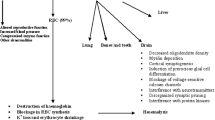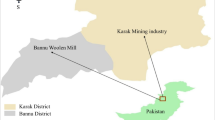Summary
Exposure of foundry workers to mixtures of different heavy metals is a very important toxicological problem. In this paper the estimation of the effects of lead, zinc, and copper on erythrocyte metabolism is presented. Concentrations of copper and zinc at work posts of the group examined did not exceed TLV, while lead concentration was 1.5 to 4 times higher than TLV. Erythrocyte metabolism was measured through activities of such glycolytic pathway enzymes as PFK, PGI, PK, aldolase and G6-PD from the hexose monophosphate pathway. Additionally the free erythrocyte protoporphyrin (FEP) level, D-ALA activity, serum GSH level, 2,3 DPG level in erythrocytes and lactic acid production during a 2-h incubation of red blood cells (RBC) was estimated. The blood-lead level, FEP level, copper concentration in erythrocytes in exposed group were significantly higher than in control group while the zinc level in erythrocytes was significantly lower. Measuring erythrocyte metabolism we showed that the activity of PGI, PFK, aldolase, lactic production and 2,3 DPG levels was significantly higher in the exposed group, probably as a result of anaerobic glycolysis activation.
Similar content being viewed by others
References
Adams KF, Johnson G, Hornowski KE, Lineberger TH (1979) The effect of copper on erythrocyte deformability a possible mechanism of hemolysis in acute intoxication. Biochim Biophys Acta 550:279–287
Apostoli P, Maranelli G (1986) The erythrocyte zinc protoporphyrin test in the biological monitoring of working populations exposed to metallic lead. Med Lav 77:529–537
Bartlett GR (1959) Human red cell glycolytic intermediates. J Biol Chem 234:449–458
Boulard M, Blume K, Bender E (1872) The effect of copper on red cell enzyme activities. J Clin Invest 51:459–461
Brewer GJ, Prasad AS, Oelshlegel FJ, Schoomaker EB, Ortega J, Oberleas D (1976) Effect of zinc on red cell oxygen affinity. Trace elements in human health and disease. In: Prasad AS (ed) Zinc and copper. Academic Press, New York, pp 286–294
Cheraskin E, Carpenter JH, Riordan HD (1986) Differences in human serum copper and zinc levels in healthy and patient populations. Med Hypothesis 20:79–85
Cools A, Salle JA, Verberk MM, Zielhuis RL (1976) Biochemical response of male volunteers ingesting inorganic lead for 49 days. Int Arch Occup Environ Health 38:129–139
Dobroszycka W, Warwas M, Osada J (1977) Biochemical studies on populations with long or short-term exposure to environmental pollution. Life Sci 7:23–27
Electrothermal Atomic Absorption Spectrophotometry Applications. Pye, 1977
Farant JP, Wigfield DC (1987) Interaction of divalent metal ions with normal and lead-inhibited human erythrocytic porphobilinogen synthase in vitro. Toxicol Appl Pharmacol 89:9–18
Fischer PW, Cironx A, L'Abbe MR (1981) The effect of dietary zinc on intestinal copper absorption. Am J Clin Nutr 34:1670–1675
Hasan J, Hernberg S (1966) Interactions of inorganic lead with human red blood cell. Work Environ Health 2:26–44
Herber RFM (1980) Estimation of blood lead values from blood porphyrin and urinary-aminolevulinic acid levels in workers. Int Arch Occup Environ Health 45:169–179
Hochstein P, Sreekumar K, Fornan SJ (1978) Mechanism of copper toxicity in red cells. Proc Clin Biol Res 21:669–686
Howard JK (1974) Human erythrocyte glutathione reductase and glucose-6-phosphate dehydrogenase activities in normal subjects and in person exposed to lead. Clin Sci Mol Med 515:520–547
Howard JK (1978) Interrelationships of glutathione reductase, -aminolevulinic dehydratase activity and free sulphydryl groups in the erythrocytes of normal and lead exposed persons. J Toxicol Environ Health 4:51–57
Jaworski JF (1978) Effects of lead in the environment. In: NRCC Associate Committee on Scientific Criteria for Environmental Quality. National Research Council, Canada
Klauder DS, Petering HC (1975) Protective value of dietary copper and iron against some toxic effects of lead in rats. Environ Health Persp 12:77–89
Klauder DS, Petering HG (1977) Anemia in lead intoxication: a role for copper. J Nutr 107:1779–1785
Lilis R, Fischbein A, Eisinger J, Blumberg WE, Diamond S, Andersen HA, Rom W, Rice C, Sarkozi L, Kon S, Selikoff IJ (1977) Prevalence of lead disease among secondary lead smelter workers and biological indicators of lead exposure. Environ Res 14:255–285
McIntire N, Clink HM, Levi AJ, Cumings JN, Sherlock Sh (1967) Hemolytic anemia in Wilson's disease. New Engl J Med 276:439–444
Manzler AD, Schreiner AW (1970) Copper-induced acute hemolytic anemia. A new complication of hemodialysis. Ann Int Med 73:409–412
Metz EN, Sagone AL (1972) The effect of copper on the erythrocyte hexose monophosphate shunt pathway. J Lac Clin Med 80:405–413
Needleman HL, Landrigan PJ (1981) The health effects of low level exposure to lead. Ann Rev Publ Health 2:277–298
Piomelli S (1973) A micromethod for free erythrocyte porphyrins: the FEP test. J Lab Clin Med 81:932–940
Ramirez-Cervantes B, Embree JW, Hine CH, Nelson KW, Varner MO, Putnam RD (1978) Health assessment of employees with different body burdens of lead. J Occup Med 20:610–617
Reinstein NH, Lönnerdal B, Keen CL, Hurley LS (1984) Zinc — copper interactions in the pregnant rat: fetal outcome and fetal zinc, copper and iron. J Nutr 114:1266–1279
Richterich R (1971) Clinical chemistry (in Polish) PZW1, Warszawa
Roels HA, Buchet JP, Lauwerys RR, Sonnet J (1975) Comparison of in vivo effect of inorganic lead and cadmium on glutathione reductase system and -amino-levulinate dehydratase inhuman erythrocytes. Br J Ind Med 32:181–192
Rogan WJ, Reigart JR, Gladen BC (1986) Association of amino-levulinate dehydratase levels and ferrochelatase inhibition in childhood lead exposure. J Pediatr 109:60–64
Sandstead HH (1987) Zinc-copper interaction provides a novel and apparently effective alternative therapy for Wilson's disease (editorial). J Lab Clin Med 109:521–522
Sartor FA, Rondia D (1981) Setting legislative norms for environmental lead exposure: result of an epidemiological survey in the East of Belgium. Toxicol Lett 7:251–257
Sawicki F (1982) Elements of statistics for physicians (in Polish). PZWL, Warszawa
Smith JL (1976) Metabolism and toxicity of lead. In: Trace elements in human health and disease metabolism and toxicity in man, vol II. Academic Press, New York, San Francisco, London, pp 443–452
Stankiewicz A (1978) Metabolical and pathophysiological role of zinc (in Polish). Post Hig Med Dośw 32:749–777
Szczeklik E (1967) Clinical enzymology (in Polish) PZWL, Warszawa
Waldron HA, Stofen D (1974) Sub-clinical lead poisoning. Academic Press, London
el Waseef A, Hashim MM (1985) Zinc lead interaction in the rabbit. Acta Med Hung 42:199–207
Zatoński W, Zawadzki J, Kwiatkowska J, Marczewski A, Smolik R (1979) Red blood cell metabolism in Wilson's disease (in Polish). Pol Tyg Lek 34:547–549
Zielitiski R (1972) Statistical tables (in Polish). PWN, Warszawa
Author information
Authors and Affiliations
Rights and permissions
About this article
Cite this article
Antonowicz, J., Andrzejak, R. & Smolik, R. Influence of heavy metal mixtures on erythrocyte metabolism. Int. Arch Occup Environ Heath 62, 195–198 (1990). https://doi.org/10.1007/BF00379431
Received:
Accepted:
Issue Date:
DOI: https://doi.org/10.1007/BF00379431




